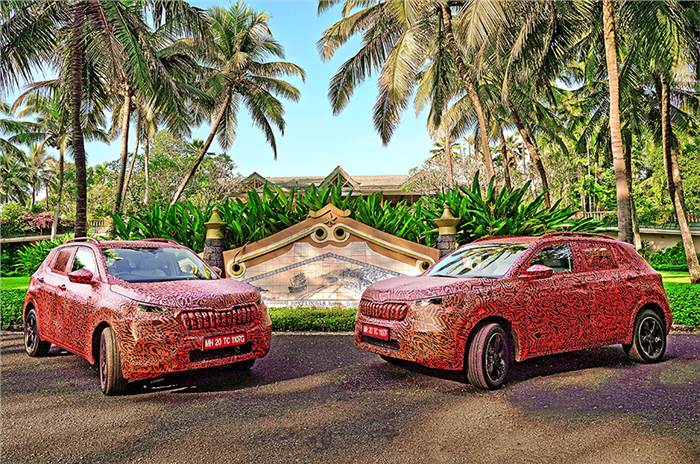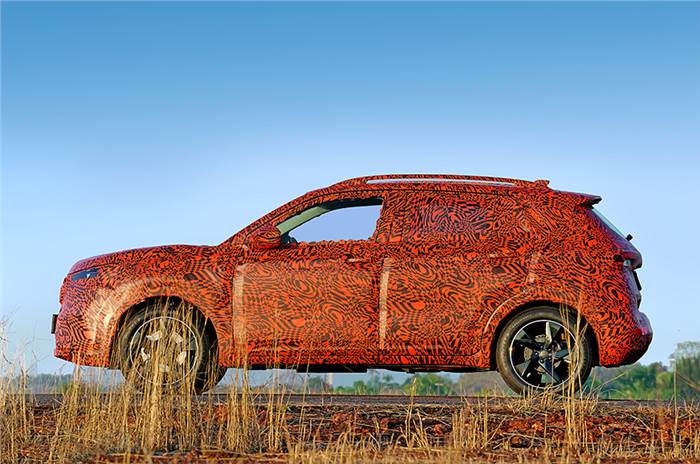Skoda Kushaq prototype review, test drive
Skoda's all-new 'made-in-India' SUV is set to go up against the likes of the Hyundai Creta and Kia Seltos. We drive a near-production model to find out what the Kushaq has to offer.
Published on Jan 25, 2021 03:00:00 PM
1,73,933 Views
Follow us on
What is the Skoda Kushaq?
Born with 93 percent local content, Skoda’s latest baby is more Indian than Czech and has fittingly been given an Indian sounding name. Say hello to the grounds-up, all-new Skoda Kushaq. Derived from the Sanskrit word ‘Kushak’ for king or emperor, it may seem that Skoda took to ‘rashi’ the Vedic, astro-numerological naming practice, in the hope that its newborn would be blessed with a long and successful life. But no, Skoda merely followed a trend it began with the Kodiaq, which is to start the names of all Skoda SUVs with the letter K and end with Q. But can the Kushaq, be true to its Sanskrit name and become the new king of SUVs? That’s the crown the Hyundai Creta, which finds over 10,000 buyers every month, has usurped and that’s the crown every SUV maker wants. However, for Skoda, the Kushaq is much more than just another SUV in the range. It’s the start of an all-new chapter in India not just for Skoda but for the VW Group.

The reimagined business, dubbed ‘India 2.0’, tears up the rule book and puts Skoda in charge of the entire VW Group’s operations in India. After a decade of trying to hack the low-margin Indian market, VW gave up and left the job to Skoda. So, whilst the VW brand leads the Group’s EV charge globally, Skoda has been entrusted with developing affordable and low-cost products for both brands into a new entity called Skoda Auto Volkswagen India Private Ltd (SAVWIPL).
The convoluted name of this new company is the vestige of a complex structure that’s been overhauled and streamlined by dovetailing three separate organisations (one Skoda and two VW) under one umbrella, which will control the future of the VW Group on the sub-continent and other emerging markets.
| Skoda Kushaq Price, Mileage, Specifications, Features and Variants | |
|---|---|
| Brand | Skoda |
| Model Name | Kushaq |
| Skoda Kushaq Price | ₹ 12.73 - 21.85 lakh |
| Skoda Kushaq Range/Mileage | Petrol : 18.09 - 19.76kpl |
| Skoda Kushaq Specifications | SUV | 4 doors | 5 seats View All Specs |
| Skoda Kushaq Features | LED headlight | 10-inch Touchscreen display | 6 airbags View All Features |
| Skoda Kushaq Variants | 1.0 TSI MT Classic | 1.0 TSI MT Onyx | 1.0 TSI AT Onyx View All Variants |
The Kushaq is the first model coming out of the India 2.0 project and has the entire weight of the VW Group riding on its haunches because expectations are very high. This model will set the standard for a range of made-for-India models coming from both Skoda and VW brands (the Taigun, the Kushaq’s sister from VW will follow a few months later), and importantly be an acid test of Skoda’s capability of delivering a car with the kind of values Indian customers want.
Skoda Kushaq: exterior and platform details
We got our first clue of what the Kushaq would look like at last year’s Auto Expo where it was unveiled in concept form as the Vision IN. What we said then is that if the production version looked anything like the stunning concept, the Koreans would have a serious headache.
And now, almost a year later, in sunny Goa we are driving an early prototype of the production version to get our first taste of it. So just how good does the Kushaq look? Unfortunately, we can’t tell you yet. Apart from it being heavily camouflaged, we’ve been strictly embargoed from talking about whatever little we’ve seen of it until the global unveil in March. Skoda doesn’t want us to spoil the surprise!
What we can talk about is what’s under the orange camo cloak. The starting point for the Kushaq is the VW Group’s MQB-A0 platform that also underpins a gigantic range of models across VW brands. The good thing is that this platform is ‘package protected’ for a growing wave of future tech that’s quickly finding its way into mass-market cars. Bits like 5G connectivity, full-digital cockpits, ADAS features and even electrification can be plugged into the MQB-A0-based cars, as and when customers or regulations demand them. The bad thing is that the MQB-A0, originally conceived for European markets, is inherently a high-cost platform and that’s been the sticking point for the viability of the India 2.0 project. However, Skoda achieved a breakthrough on costs by heavy localisation and the first Kushaq will roll off the Chakan assembly line with more than 90 percent of local parts. That’s a mind-boggling achievement when you consider that over the previous 10 years, the VW Group couldn’t localise their cars beyond 76 percent. Also, Skoda has carefully specced the Kushaq to Indian requirements, which has also eked out substantial cost savings. There’s no point designing components for -40 degC in a country where the ambient temperatures constantly hit 40+ degC. This leads us to speculate on the price. Obviously, it’s too early for Skoda to comment on that all-important figure but company officials have hinted that the Creta and Seltos is what they are gunning for. At the same time, the Kushaq will carry "the premium the Skoda badge commands". Make what you will of these cryptic hints, but we expect the Kushaq to be very competitively priced to make the most of the one crucial shot Skoda has to get customers flocking to its showrooms.
Skoda Kushaq: interior details
The exact dimensions of the Kushaq haven’t been disclosed yet, except for the wheelbase, which, at 2,651mm, puts the Skoda right at the heart of midsize SUV territory. The generous wheelbase, which is the longest in the class, bodes well for interior space, especially at the rear. So, let’s begin by slipping into the backseat. The first impression is that there’s enough space for six-footers to stretch out, a deep squab that nicely supports your thighs, and an optimally angled backrest that can be flipped down to enhance the versatility of the spacious boot. The seat cushioning and foam density is being further tweaked to optimise comfort even further before the launch. The cabin isn’t particularly wide and the contoured seats make the rear seat best for two people. Also the high-set front seat and high window line infringe on visibility a bit. Interestingly, Skoda has flattened the transmission tunnel a bit to make it comfier for the third passenger. What this also suggests is that there will be no 4x4 option.
Up front, a pair of heavily contoured seats do a great job in delivering a supremely comfortable seating position too. The ergonomics are spot on and overall visibility out front is superb.
Skoda Kushaq: engine and performance details
The Kushaq will come with two direct-injection turbo-petrol TSI engines – a 1.0-litre three-cylinder and a 1.5-litre four-cylinder unit, both with manual and automatic transmission options. There’s no diesel planned. The 1.0 TSI gets the same 6-speed manual and 6-speed torque converter combo as in the current Rapid, whilst the 1.5 TSI version, in addition to the 6-speed manual, gets a 7-speed DSG transmission. On this prototype drive, we have two variants to test – the 1.0 TSI manual and the 1.5 TSI auto.
We’ve sampled the fabulous 1.5 TSI and 7-speed DSG package in the VW T-Roc and the 1.0-litre with the 6-speed manual in the Rapid, so we had a fair idea of what to expect. But between the two, it was the 1.0 litre TSI that was the surprise, impressing us even more than the significantly powerful 1.5 TSI. The 1.0 TSI feels like a different animal under the hood of the Kushaq. Firstly, the engine is remarkably smooth at idle and rocks less on its mounts than in the Rapid. Skoda engineers confirmed that the engine mounts have been tweaked “to improve smoothness”, and the stiffer MQB platform helps too.
Slot the stubby gearlever into first and the improvement in shift quality over the manual Rapid is noticeable too. The same 6-speeder in the Kushaq benefits from redesigned gearbox linkages for a better shift. The only fly in the ointment is the clutch, which can be a touch snappy and could do with a more progressive bite.

South Goa’s narrow, winding and relatively traffic-free roads allow us to exploit certain facets of the Kushaq. The 1.0 TSI doesn’t cease to astound me and makes a mockery of the age-old ‘there’s no replacement for displacement’ claim. Except for some sluggishness when you stomp your right foot at low revs, the 1.0 TSI doesn’t leave you wanting. The hallmark of this engine is its broad spread of torque, which builds up smoothly from as low as 2,000rpm and the strong surge doesn’t tail off until you hit the 6,200rpm limiter. Riding the meaty mid-range and letting the engine operate in the 2,500 to 4,000rpm zone is where the Kushaq feels best. You don’t feel the need to keep shifting down every time the revs drop. The engine will happily spin past 6,000rpm too. It’s just that, at higher revs, the engine does get a touch noisy, which makes you automatically throttle back to a more relaxed pace.
Where Skoda has absolutely aced it is with the dynamics, and though this a prototype, I will stick my neck out and say that the Kushaq will set a new benchmark for ride and handling in its class when it's launched, trumping even the ageing but still dynamically brilliant Renault Duster.
Apart from a fair bit of slack around the straight ahead position, the steering is perfectly weighted; it's light enough to make low-speed driving and parking easy and has enough heft to give you the confidence to drive fast.
And confidence is something the Kushaq gives you in abundance. It has a remarkably flat ride even on bumpy road and the overall poise at high speeds will make it a great highway car. The best bit is that this taut body control hasn’t come at the expense of ride. Ruts, speed breakers and sharp edges are nicely muffled, helped in no small measure by the 205/55 R17 tyres.
Switching to the 1.5 TSI 7-speed auto didn’t heighten the driving experience as much I thought it would. Sure, you can feel the extra slug of power and torque, the moment you tap the throttle, but the DSG, with its characteristic momentary hesitation after you put your foot down, doesn’t give you the same direct connect with the engine as a manual. That said, the 7-speed DSG is still easily the best twin-clutch auto transmission around and far smoother and responsive than the DCTs in the Seltos and Creta and upshifts are incredibly quick and seamless. You won’t complain about a lack of performance either in the 1.5 Kushaq. And judging by the quick bursts of acceleration we indulged in, I’m pretty confident, the Kushaq will be faster than its Korean rivals.
In auto mode, the DSG has been programmed to upshift quite early, but use the manual option and the transmission holds onto each gear longer. It’s just that, like the 1.0 TSI, there’s a fair bit of engine noise seeping into the cabin when you near the redline.
A marked difference between the 1.0 and 1.5 TSI is in the way they handle. The 1.5 Kushaq feels distinctly more nose-heavy and pitches a bit on an undulating road, despite a stiffer suspension to factor in the heavier engine. The 1.0 Kushaq, in contrast, feels lighter on its feet, turning into corners with more verve. Both variants of the Kushaq have some body roll but it's well-contained and neither will feel like a handful.
Skoda Kushaq: features and equipment details
But how well equipped is the Kushaq? After all, it's gadgets and gizmos that customers want above everything else in their car. Again, Skoda has embargoed the features list until the world premiere, but what we can share is the suite of safety features across all variants that includes, electronic stability control (a segment first), six airbags, hill hold control, ISOFIX tethers for the rear seats, rain/light sensor, and a tyre monitoring system. What we can also confirm is that the Kushaq will come with a standard sunroof and not the more sought-after panoramic one.
We haven’t been able to comment on key areas like the cabin, how it looks, how it feels and how well equipped it is. But if what we’ve experienced so far is an indicator of what the final product will be, it’s fair to say that the Kushaq will be the most comprehensively engineered and well-built SUV for the money. We can’t wait to see and drive it with its disguise off.
Also see:
Skoda Kushaq prototype video review
2021 Skoda Rapid Rider priced at Rs 7.79 lakh
2021 Skoda Superb launched at Rs 31.99 lakh
Tech Specs 
Copyright (c) Autocar India. All rights reserved.






 Engine
Engine Transmission
Transmission Dimensions
Dimensions
Comments
Member Login
Personal Details
No comments yet. Be the first to comment.